The WiFi alarm system market is projected to expand from USD 1,583.6 million in 2025 to USD 2,679.5 million by 2035, reflecting a CAGR of 5.4%. Dividing the decade into two half-decade blocks provides insight into the weighted contribution of each period to overall growth. In the first half, 2025 to 2030, the market experiences strong momentum, driven by adoption in residential, commercial, and small enterprise segments. Rising awareness of smart home security solutions, remote monitoring, and mobile integration supports significant uptake. During this period, manufacturers focus on enhancing system compatibility, ease of installation, and mobile app functionality, capturing substantial revenue and establishing brand presence.
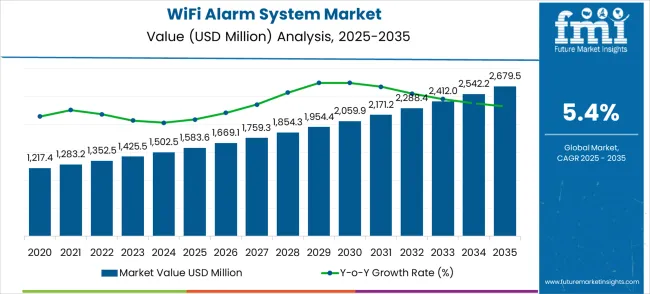
In the second half of the decade, 2030 to 2035, growth remains steady but contributes slightly more to total market expansion due to increasing penetration in emerging economies and upgrades in existing installations. Technological advancements, including AI-powered intrusion detection, energy-efficient components, and integration with broader smart home ecosystems, sustain adoption. This half-decade weighted growth analysis indicates that while early adoption builds a solid foundation, incremental gains from technological innovation, system upgrades, and regional expansion significantly amplify overall growth. The pattern highlights opportunities for manufacturers to balance initial market entry strategies with long-term product enhancement and regional diversification to optimize revenue generation across the decade.
The WiFi alarm system market is divided into residential security (42%), commercial properties (28%), industrial facilities (15%), healthcare and educational institutions (10%), and specialty applications such as retail and logistics hubs (5%). Residential security drives adoption due to growing demand for smart home solutions, remote monitoring, and easy integration with mobile devices. Commercial properties use WiFi alarm systems for intrusion detection, access control, and operational safety. Industrial facilities rely on them for asset protection and workplace monitoring. Healthcare and educational institutions implement these systems to safeguard sensitive areas and ensure occupant safety. Specialty applications include warehouses, retail chains, and distribution centers requiring scalable and connected security solutions.
Current trends include integration with IoT devices, cloud-based monitoring, AI-driven threat detection, and mobile app interfaces. Manufacturers are innovating with battery-backed, compact, and easy-to-install systems. Expansion into smart buildings, connected homes, and commercial IoT security networks is accelerating adoption. Partnerships between device providers and service platforms enable customized, scalable, and real-time monitoring solutions. Focus on user convenience, operational reliability, and enhanced connectivity continues to drive global market growth.
| Metric | Value |
|---|---|
| Market Value (2025) | USD 1,583.6 million |
| Market Forecast Value (2035) | USD 2,679.5 million |
| Forecast CAGR (2025–2035) | 5.4% |
Market expansion is being supported by the rapid adoption of smart home technologies across global residential markets and the corresponding need for integrated security solutions that provide real-time monitoring and automated response capabilities. Modern property owners require advanced security technologies that can provide reliable intrusion detection, remote accessibility, and seamless integration with existing smart home ecosystems. The superior connectivity options and mobile app integration characteristics of WiFi alarm systems make them essential components in comprehensive home security installations where remote monitoring and instant notification capabilities are critical for property protection.
The growing focus on personal safety and property protection is driving demand for intelligent security technologies from certified manufacturers with proven track records of reliability and system performance. Property owners are increasingly investing in WiFi alarm systems that offer comprehensive monitoring capabilities while enabling remote control and real-time alert functionalities. Insurance requirements and security standards are establishing performance benchmarks that favor advanced WiFi-enabled alarm solutions with multi-layer connectivity and intelligent detection capabilities.
The market is segmented by connectivity type, application, and region. By connectivity type, the market is divided into WIFI + GSM + APP and WIFI + GSM configurations. Based on application, the market is categorized into home and commercial segments. Regionally, the market is divided into North America, Europe, East Asia, South Asia & Pacific, Latin America, and Middle East & Africa.
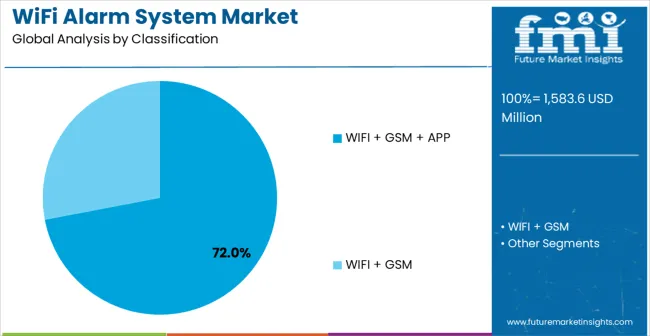
WIFI + GSM + APP connectivity configurations are projected to account for 72% of the WiFi alarm system market in 2025. This leading share is supported by the comprehensive connectivity options, enhanced reliability, and superior user experience that triple connectivity systems offer for diverse security applications. WIFI + GSM + APP systems provide primary WiFi connectivity with GSM backup and dedicated mobile app control, making them the preferred choice for residential homes, small businesses, and commercial properties requiring reliable security monitoring. The segment benefits from technological advancements that have improved app functionality, reduced false alarm rates, and enhanced system integration capabilities.
Modern WIFI + GSM + APP alarm systems incorporate advanced wireless communication protocols, intelligent sensor technologies, and sophisticated mobile applications that deliver exceptional security performance while maintaining user-friendly operation and comprehensive remote control capabilities. These innovations have significantly improved system reliability while maintaining compatibility with various smart home platforms and reducing installation complexity through wireless configuration and automated setup procedures. The residential security sector particularly drives demand for triple connectivity solutions, as homeowners require reliable security systems that can operate effectively even during internet or power outages.
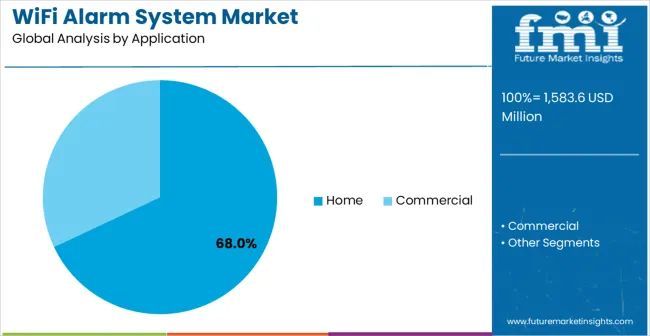
Home applications are expected to represent 68% of WiFi alarm system demand in 2025. This dominant share reflects the critical importance of residential security in modern living and the need for reliable protection systems capable of safeguarding families and property assets across diverse housing types and neighborhood environments. Homeowners require advanced and user-friendly alarm systems for single-family homes, apartments, condominiums, and vacation properties. The segment benefits from ongoing smart home adoption trends and increasing consumer awareness of home security importance driven by crime statistics and insurance requirements.
Home security applications demand exceptional alarm system performance to ensure reliable intrusion detection, environmental monitoring, and emergency response capabilities that protect families and property while providing peace of mind during travel and daily activities. These applications require alarm systems capable of handling various sensor types, maintaining reliable communication with monitoring services, and providing intuitive user interfaces for all family members including elderly users and children.
The WiFi alarm system market is advancing steadily due to increasing home security awareness and growing recognition of connected security system importance in property protection and family safety. The market faces challenges including cybersecurity concerns related to wireless connectivity, need for reliable internet connectivity for optimal performance, and varying local regulations across different markets affecting system features. Standardization efforts and certification programs continue to influence alarm system quality and market development patterns.
The growing deployment of artificial intelligence algorithms and smart analytics platforms is enabling advanced threat detection capabilities and significant reduction in false alarm incidents through intelligent pattern recognition and behavioral analysis. AI-powered systems and machine learning algorithms provide continuous monitoring optimization while enabling predictive security analysis and automated response protocols based on historical data and threat patterns. These technologies are particularly valuable for commercial properties and multi-residence facilities that require sophisticated threat assessment and automated response capabilities.
Modern alarm system manufacturers are incorporating comprehensive IoT connectivity and smart home ecosystem integration that enables seamless operation with various connected devices while providing centralized control through unified platforms. Integration of voice assistants, smart cameras, and automated lighting systems enables significant enhancement in overall security effectiveness and user convenience compared to traditional standalone alarm systems. Advanced sensor fusion and multi-device coordination also support development of more comprehensive and responsive security solutions for modern connected homes.
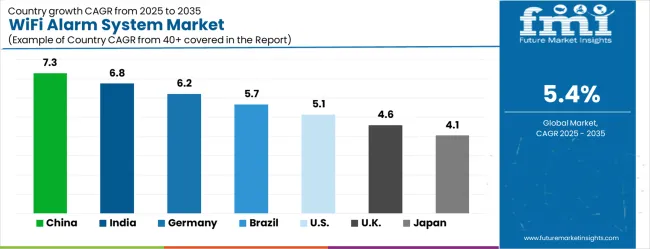
| Country | CAGR (2025–2035) |
|---|---|
| China | 7.3% |
| India | 6.8% |
| Germany | 6.2% |
| Brazil | 5.7% |
| United States | 5.1% |
| United Kingdom | 4.6% |
| Japan | 4.1% |
The WiFi alarm system market is growing steadily, with China leading at a 7.3% CAGR through 2035, driven by rapid urbanization, increasing disposable income, and growing security consciousness among middle-class consumers in expanding metropolitan areas. India follows at 6.8%, supported by rising property ownership across urban centers and increasing investments in home security infrastructure driven by expanding residential development projects. Germany records strong growth at 6.2%, prioritizing high-quality security solutions, comprehensive building automation, and advanced technology integration in residential and commercial properties. Brazil grows steadily at 5.7%, integrating WiFi alarm systems into expanding middle-class housing developments and commercial security installations. The United States shows solid growth at 5.1%, focusing on smart home integration and advanced security technology adoption. The United Kingdom maintains steady expansion at 4.6%, supported by home automation trends and insurance-driven security adoption. Japan demonstrates consistent growth at 4.1%, prioritizing technological innovation and aging population security needs.
The report covers an in-depth analysis of 40+ countries, Top-performing countries are highlighted below.
The demand for WiFi alarm system installations in China is projected to exhibit the highest growth rate with a CAGR of 7.3% through 2035, driven by massive urbanization programs and comprehensive middle-class expansion creating significant demand for home security solutions across newly developed residential communities. The country's growing property ownership rates and expanding smart home adoption are creating substantial opportunities for WiFi alarm system deployment in apartments, condominiums, and single-family homes. Major security system providers are establishing comprehensive distribution networks to support large-scale residential developments and meet growing consumer security requirements.
The WiFi alarm system installations market in India is expanding at a CAGR of 6.8%, supported by rapid urban property development and increasing middle-class security awareness driving demand for reliable and cost-effective home security solutions. The country's expanding real estate sector and growing smartphone adoption are creating opportunities for WiFi alarm systems that provide comprehensive security monitoring with affordable monthly service costs. Security system companies are investing in localized solutions to support growing residential security demand and diverse housing types.
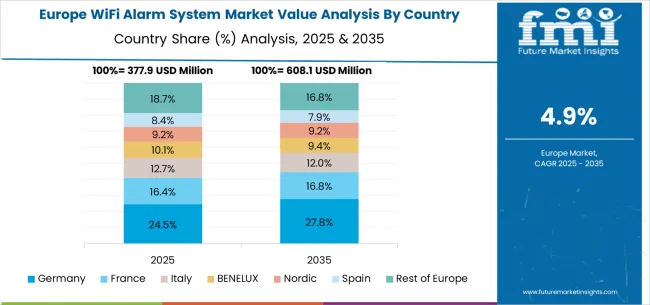
Demand for WiFi alarm system installations in Germany is projected to grow at a CAGR of 6.2%, supported by the country's focus on high-quality security solutions and comprehensive building automation systems requiring advanced integration capabilities. German property owners are implementing sophisticated alarm systems that support smart home integration, energy management, and comprehensive property monitoring. The market is characterized by focus on system reliability, privacy protection, and compliance with stringent data security regulations.
The WiFi alarm system installations market in Brazil is growing at a CAGR of 5.7%, driven by expanding middle-class housing developments and increasing commercial property security requirements across major urban centers. The country's growing property investment sector and expanding retail infrastructure are creating demand for alarm systems that support comprehensive premises protection and remote monitoring capabilities. Security companies are adapting solutions to support diverse property types and local installation requirements.
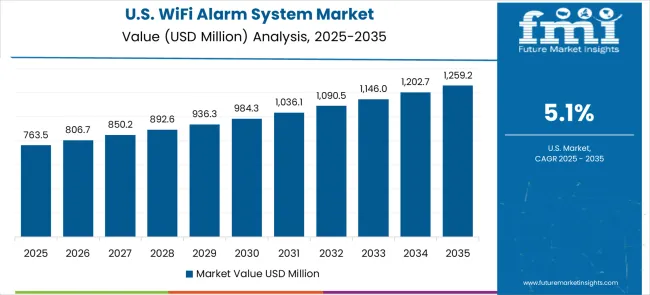
Demand for WiFi alarm system installations in the United States is expanding at a CAGR of 5.1%, driven by increasing smart home adoption and growing consumer demand for integrated security solutions supporting comprehensive home automation and energy management. Property owners and technology enthusiasts are implementing advanced alarm systems that support voice assistant integration, automated response protocols, and comprehensive device connectivity. The market benefits from innovation in security technologies and widespread adoption of DIY installation preferences.
The WiFi alarm system installations market in the United Kingdom is projected to grow at a CAGR of 4.6%, supported by comprehensive home automation adoption and insurance industry programs encouraging security system installation for premium reductions. Property owners and homebuyers are investing in alarm systems that provide comprehensive monitoring capabilities and support integration with existing smart home devices and energy management systems. The market is characterized by focus on user experience, system reliability, and compliance with insurance requirements.
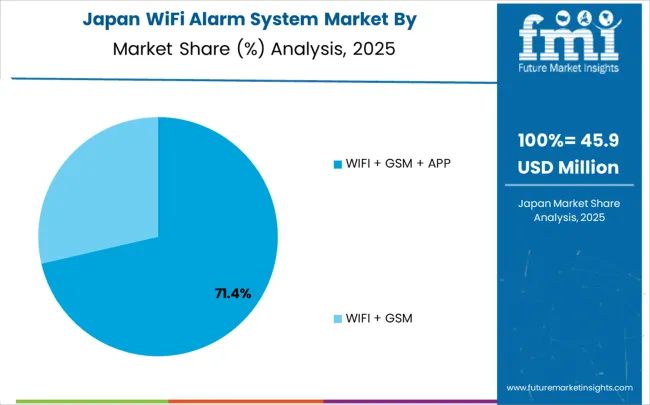
Demand for WiFi alarm system installations in Japan is expanding at a CAGR of 4.1%, driven by aging population security needs and technological innovation requiring advanced monitoring capabilities supporting elderly care and comprehensive property protection. Japanese property owners are implementing sophisticated alarm systems that incorporate health monitoring, emergency response, and comprehensive family communication features. The market benefits from focus on reliability, technological advancement, and user-friendly operation for diverse age groups.
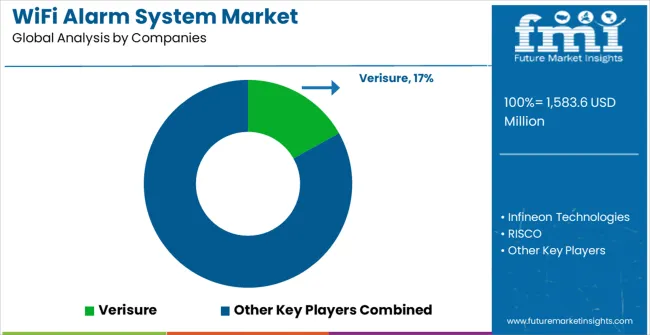
The WiFi alarm system market is defined by competition among established security companies, technology providers, and emerging smart home solution firms. Companies are investing in advanced wireless technologies, mobile application development, cloud-based monitoring services, and professional installation support to deliver reliable, user-friendly, and comprehensive security solutions. Strategic partnerships, technological advancement, and geographic expansion are central to strengthening product portfolios and market presence.
Verisure, operating globally, offers comprehensive alarm system solutions with focus on professional monitoring services, reliable connectivity, and customer support excellence. Infineon Technologies, multinational semiconductor company, provides advanced wireless communication technologies and security chips enabling intelligent alarm system functionality. RISCO, security specialist, delivers comprehensive alarm solutions with focus on wireless communication and system integration capabilities. Vivint offers integrated smart home security systems with professional installation and comprehensive monitoring services.
Eaton provides industrial and residential security systems with prioritize on power management integration and reliable operation. ADT delivers comprehensive security monitoring services with professional installation and 24/7 monitoring capabilities. Honeywell offers advanced alarm technologies with focus on commercial applications and building automation integration. Bosch provides comprehensive security solutions with prioritize on quality, reliability, and system integration.
Securitas, Zuden Technology, Shenzhen Mingqian Technology, Chuango AIoT Technology Corp., Shenzhen Kerui Smart Technology, and Chengdu Gisemi Microelectronics offer specialized security expertise, regional manufacturing capabilities, and technical support across global and regional markets.
The WiFi alarm system market underpins residential security enhancement, commercial property protection, smart home ecosystem development, and community safety improvement. With digitalization trends, increasing security awareness, and demand for remote monitoring capabilities, the sector must balance cost accessibility, system reliability, and user experience optimization. Coordinated contributions from governments, security associations, technology providers, service companies, and investors will accelerate the transition toward intelligent, connected, and highly responsive security systems.
| Item | Value |
|---|---|
| Quantitative Units | USD 1,583.6 million |
| Connectivity Type | WIFI + GSM + APP, WIFI + GSM |
| Application | Home, Commercial |
| Regions Covered | North America, Europe, East Asia, South Asia & Pacific, Latin America, Middle East & Africa |
| Country Covered | United States, Germany, India, China, United Kingdom, Japan, Brazil, and other 40+ countries |
| Key Companies Profiled | Verisure, Infineon Technologies, RISCO, Vivint, Eaton, ADT, Honeywell, Bosch, Securitas, Zuden Technology, Shenzhen Mingqian Technology, Chuango AIoT Technology Corp., Shenzhen Kerui Smart Technology, Chengdu Gisemi Microelectronics |
| Additional Attributes | Dollar sales by connectivity type and application, regional demand trends across North America, Europe, and Asia-Pacific, competitive landscape with established security providers and emerging technology specialists, deployment preferences for multi-connectivity versus dual-connectivity configurations, integration with smart home ecosystems and professional monitoring services, innovations in wireless communication technologies and mobile applications for enhanced user experience and system reliability, and adoption of AI-powered detection systems with cloud-based monitoring and automated response capabilities for improved security effectiveness and reduced false alarms. |
The global WiFi alarm system market is estimated to be valued at USD 1,583.6 million in 2025.
The market size for the WiFi alarm system market is projected to reach USD 2,679.5 million by 2035.
The WiFi alarm system market is expected to grow at a 5.4% CAGR between 2025 and 2035.
The key product types in WiFi alarm system market are WiFi + gsm + app and WiFi + gsm.
In terms of application, home segment to command 68.0% share in the WiFi alarm system market in 2025.






Our Research Products

The "Full Research Suite" delivers actionable market intel, deep dives on markets or technologies, so clients act faster, cut risk, and unlock growth.

The Leaderboard benchmarks and ranks top vendors, classifying them as Established Leaders, Leading Challengers, or Disruptors & Challengers.

Locates where complements amplify value and substitutes erode it, forecasting net impact by horizon

We deliver granular, decision-grade intel: market sizing, 5-year forecasts, pricing, adoption, usage, revenue, and operational KPIs—plus competitor tracking, regulation, and value chains—across 60 countries broadly.

Spot the shifts before they hit your P&L. We track inflection points, adoption curves, pricing moves, and ecosystem plays to show where demand is heading, why it is changing, and what to do next across high-growth markets and disruptive tech

Real-time reads of user behavior. We track shifting priorities, perceptions of today’s and next-gen services, and provider experience, then pace how fast tech moves from trial to adoption, blending buyer, consumer, and channel inputs with social signals (#WhySwitch, #UX).

Partner with our analyst team to build a custom report designed around your business priorities. From analysing market trends to assessing competitors or crafting bespoke datasets, we tailor insights to your needs.
Supplier Intelligence
Discovery & Profiling
Capacity & Footprint
Performance & Risk
Compliance & Governance
Commercial Readiness
Who Supplies Whom
Scorecards & Shortlists
Playbooks & Docs
Category Intelligence
Definition & Scope
Demand & Use Cases
Cost Drivers
Market Structure
Supply Chain Map
Trade & Policy
Operating Norms
Deliverables
Buyer Intelligence
Account Basics
Spend & Scope
Procurement Model
Vendor Requirements
Terms & Policies
Entry Strategy
Pain Points & Triggers
Outputs
Pricing Analysis
Benchmarks
Trends
Should-Cost
Indexation
Landed Cost
Commercial Terms
Deliverables
Brand Analysis
Positioning & Value Prop
Share & Presence
Customer Evidence
Go-to-Market
Digital & Reputation
Compliance & Trust
KPIs & Gaps
Outputs
Full Research Suite comprises of:
Market outlook & trends analysis
Interviews & case studies
Strategic recommendations
Vendor profiles & capabilities analysis
5-year forecasts
8 regions and 60+ country-level data splits
Market segment data splits
12 months of continuous data updates
DELIVERED AS:
PDF EXCEL ONLINE
WiFi Extenders Market Size and Share Forecast Outlook 2025 to 2035
WiFi as a Service Market Size and Share Forecast Outlook 2025 to 2035
Industrial WiFi Module Market Size and Share Forecast Outlook 2025 to 2035
Alarm Management System Market Analysis by Component, Industry and Region - Trends, Growth & Forecast 2025 to 2035
Fire Alarm Systems Market by Solution by Application & Region Forecast till 2035
SCADA Alarm Management Market Size and Share Forecast Outlook 2025 to 2035
Smoke Alarm Market Trends- Growth & Industry Outlook 2025 to 2035
Burglar Alarm Systems Market Size and Share Forecast Outlook 2025 to 2035
Security Alarm Communicator Market Size and Share Forecast Outlook 2025 to 2035
The Clinical Alarm Management Market is segmented by component, deployment mode and end user from 2025 to 2035
Wind Speed Alarm Market
Plug-in Pump Alarm Market Analysis - Size, Share, and Forecast Outlook 2025 to 2035
Smoke and Carbon Monoxide Alarm Market Size and Share Forecast Outlook 2025 to 2035
Vibration Fiber Optic Perimeter Alarm System Market Size and Share Forecast Outlook 2025 to 2035
System-On-Package Market Size and Share Forecast Outlook 2025 to 2035
Systems Administration Management Tools Market Size and Share Forecast Outlook 2025 to 2035
Systemic Sclerosis Treatment Market - Trends & Forecast 2025 to 2035
System on Module Market Growth – Trends & Forecast 2025 to 2035
SLE Drugs Market Insights - Growth & Forecast 2025 to 2035
Systemic Mastocytosis Treatment Market

Thank you!
You will receive an email from our Business Development Manager. Please be sure to check your SPAM/JUNK folder too.
Chat With
MaRIA